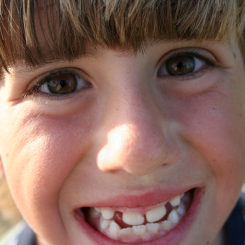
WHEN WE PICTURE SOMEONE with braces, we usually picture a teenager with a mouthful of colorful brackets. What we don’t typically picture is orthodontic appliances on younger children. However, interceptive orthodontics can reduce the need for tooth extraction and jaw surgery, correct certain problems as they appear, encourage better facial development, shorten the length of orthodontic treatment needed later on, and leave patients with a better overall result in the end.
Interceptive Orthodontics Heads Off Problems Early
Conventional wisdom argues that orthodontic treatment shouldn’t start until all the adult teeth have grown in, but some issues with bite, alignment, and facial development can show up long before those teeth do. That’s where interceptive or “Phase 1” orthodontics comes in. An orthodontist can help your child’s jaw bones grow properly to have more room for the adult teeth and provide the structure for a healthier bite. Correcting problems like malocclusions (bad bites) as they appear makes future orthodontic treatment much faster and easier — and, in some cases, unnecessary!
Causes Of Malocclusions In Children
Interceptive orthodontics seeks to correct problems with jaw growth and damage from harmful habits such as thumb sucking, nail biting, tongue thrusting, and mouth breathing. Each of these habits contributes to bite problems such as a narrow upper arch, an underdeveloped lower jaw, a deep bite, and an open bite, as well as dental crowding, which in turn can make it difficult to chew and swallow effectively and speak clearly. The purpose of Phase 1 treatment is to stop those habits if they persist or repair the damage so that the adult teeth can grow in where they should.
Don’t see how something like mouth breathing can cause dental problems? Watch this video:
Common Phase 1 Treatments
One of the most noticeable differences between Phase 1 and Phase 2 orthodontics is that Phase 1 is less focused on actual braces. Those typically come later, if they are still needed. Some of the treatments commonly used in Phase 1 include:
- Upper jaw expansion to eliminate a crossbite
- Expansion of one or both jaws to create more room for adult teeth
- Early extraction of specific baby teeth to help adult teeth come in properly
- Keeping space open for permanent teeth after premature loss of a baby tooth
- Reduction of upper front teeth protrusion to protect from trauma
Is Your Child A Candidate For Interceptive Orthodontics?
Phase 1 orthodontics works better for correcting some problems than others. The best way you can find out if it can help your child get the healthy, properly aligned smile they deserve is to bring them in for an orthodontic consultation around age 7 — especially if you’ve noticed any obvious bite problems or if they have one or more of those harmful oral health habits. In the meantime, keep encouraging them to do their brushing and flossing!
